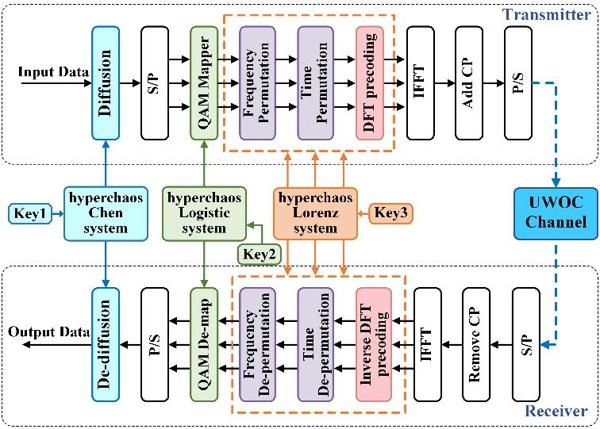With the increasing human underwater activities, such as environmental monitoring, underwater exploration, and scientific data collection, it is urgent to develop a safe, reliable, and high-speed underwater wireless communication technology. As an important supplementary technology for underwater wireless networks, underwater wireless optical communication (UWOC) has attracted the attention of many researchers in recent years due to its advantages of high bandwidth, low latency, and low power consumption. However, due to the open characteristic of UWOC systems, the gradual diffusion of the propagating beam in long distances, and the scattering effect of water, the transmission data is highly susceptible to detection, interception, and monitoring by illegal users, which leads to information leakage. From a wireless coverage perspective, security and privacy are equally important as data rate. For certain special cases, such as UWOC systems deployed in unattended, opaque, or even hostile waters or underwater multi-user communications, the security of information transmission is even more important than the data rate. Hence, the security enhancement of UWOC turns into a critical and unavoidable issue in practical application.
Currently, research on UWOC security is relatively rare, leaving space for potential attackers. In recent years, higher-order modulated stream, phase deflection, and two-layer chaotic encryption UWOC algorithms have been proposed to enhance the security. Nevertheless, all suffer from the drawbacks of small key space, low encryption dimension, and inability to resist the highly threatening chosen plaintext attacks (CPAs). Therefore, the above algorithms might be insufficient for higher information security requirements.
The research group led by Prof. Jing Xu from Zhejiang University (The master student Huan Deng is the first author.) proposed and experimentally demonstrated a UWOC encryption scheme with orthogonal frequency division multiplexing (OFDM) modulation, based on three-layer chaotic encryption and chaotic discrete Fourier transform (DFT) precoding. The research results are published in Chinese Optics Letters , Volume 20, No.11, 2022 (H. Deng, et al., Security enhancement for OFDM-UWOC system using three-layer chaotic encryption and chaotic DFT precoding). This scheme can guarantee the transmission performance while achieving a higher information confidentiality, as shown in the schematic diagram below.

Fig. 1. Principle block diagram of the OFDM-UWOC encryption system.
The three-layer chaotic encryption processes are bitstream diffusion, in-phase/quadrature (I/Q) encryption, and time-frequency scrambling. Notably, bidirectional diffusion can associate the ciphertext with the preceding and following plaintext, generating dynamic ciphertext to resist CPAs. Time-frequency permutation is similar to bit interleaving, which can improve the communication performance to some extent in the case of burst noise. The chaotic DFT precoding is used to compensate for the performance loss caused by diffusion encryption. The application of multiple hyperchaotic maps and multi-fold data encryption can improve the key space and reduce the risk of the scrambling method and chaotic model being statistically cracked. To verify the feasibility of the scheme, a 3-Gbps encrypted 16-quadrature amplitude modulation (16-QAM) OFDM signal is successfully demonstrated in a classic UWOC system.
This work enables the UWOC system to resist not only brute force attacks and statistical attacks, but also extremely threatening CPAs, implying great potential for high-speed UWOC systems in the future with higher security requirements. In the subsequent work, Prof. Xu's research group will focus on further improving the encryption efficiency and realizing real-time transmission of encrypted signals in UWOC.


